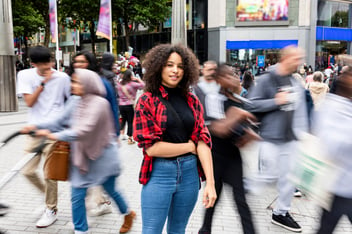Personalisation boosts customer loyalty. Here’s why.
In this article, we’ll uncover the secrets to tailoring products, services, and marketing messages to meet individual customer preferences and needs, leading to deeper connections and increased engagement. We’ll also explore how personalised experiences build trust, streamline the customer journey, and foster emotional connections, ultimately driving long-term brand advocacy and sustainable growth.

Imagine a world tailored to you
Imagine a world where every brand communication is tailored to your unique preferences and needs – from travel deals to grocery discounts and online shopping experiences.
In our modern world, customers are bombarded with messages from countless brands, each vying for attention. Brands use physical channels (like poster sites and billboards) and digital channels like emails and social media ads to advertise their offerings. If brands want to drive loyalty, however, they must think about personalising interactions for their customers.
According to McKinsey & Company, personalisation is when seller organisations use data to tailor messages to specific users' preferences. Another definition suggests that brand personalisation involves collecting and analysing data to extract insights that help create a unique experience for everyone.
Personalising messages and experiences can set your brand’s loyalty programme apart. By speaking to your customers in a way that feels personal and attentive to their needs, you make your brand more memorable.
What does good personalisation look like?
In today's competitive landscape, being personal goes beyond mere personalisation. While it's easy to insert someone's name into an email or offer a generic discount, truly being personal requires a deeper understanding and thoughtful consideration of individual preferences and needs. It's about creating experiences that resonate on a personal level, fostering genuine connections and loyalty.
Effective personalisation is not just about using data to tailor messages; it’s about building a relationship where the customer feels valued and understood. This involves anticipating needs, providing relevant solutions, and engaging in meaningful interactions. In this section, we’ll explore the nuances that distinguish good personalisation from superficial efforts and highlight strategies that brands can use to achieve this deeper level of connection.
We've identified a few effective ways brands can personalise their loyalty programmes:
1. Onboarding Processes: First impressions count. From the onset, it’s crucial to make members feel valued and cared for as individuals, not just as paying customers. This can be achieved through a personalised welcome that is user-friendly and seamless. For example, using your member’s name in messaging. According to Siddhartha Gupta, Chief Executive Officer at Mercer-Mettl, in calling customers by name you are putting a ‘human touch’ to a ‘transactional relationship’, making the communication more genuine. He goes on to say that this, consciously or subconsciously, makes customers become more ‘comfortable and open’.
2. Utilising Customer Data: Brands running successful loyalty programmes have an incredible resource: customer data. Once you have consent to collect customer data, you can craft tailored experiences catering to individual needs. Knowing the locations of your customers allows you to tailor offerings accordingly, such as specific deals with nearby stores or geo-tagging to offer promotions based on seasonal deals or local events. Another useful form of data is spending history. Understanding where customers usually spend and earn points enables you to build offers based on their regular spending habits and tailor rewards to align with what they are most likely to redeem.
3. Personalised Communication Channels: Another way to personalise loyalty programmes is by utilising personalised communication channels. Brands can engage customers through their preferred communication channels — be it email, SMS, social media, or in-app notifications. This method ensures that customers receive messages where they are most likely to engage with them. For example, Starbucks uses its mobile app to send personalised offers and rewards based on the customer's purchasing history and preferences. Starbucks' use of artificial intelligence (AI) to personalise customer interactions has significantly boosted customer engagement and sales.
Brands like Netflix, Marriott Bonvoy, and American Airlines exemplify successful personalisation:
- Streaming service Netflix uses viewer data to recommend shows and movies based on what a viewer has previously watched.
- Marriot Bonvoy offers personalised travel experiences through customer data. This can include preferences from previous holiday locations to room types often chosen. They go even further using this data to offer perks such as spa treatments or access to hotel lounges.
- American Airlines’ Aadvantage programme recommends holiday destinations to customers as well as targeted promotions based on data such as travel history.
By leveraging data in this manner, brands demonstrate how much they value their customers. As highlighted in our earlier article on loyalty trends for 2024, building an emotional connection is crucial for driving loyalty. Personalised experiences encourage further interaction and deepen customer relationships.
Getting this right means delivering the right message at the perfect moment, effectively inspiring customers precisely when they need it most. This approach not only helps them navigate their own needs but also achieves a truly personal connection. However, achieving this level of personalization is a challenging task.
Why personalisation matters
Personalisation is instrumental in sustaining long-term customer loyalty. It can be seen as a form of inclusion. By personalising experiences and interactions, you address individual customer needs, making them feel seen and valued. This commitment to understanding your consumers sets you apart as a brand.
When customers recognise these efforts, they build an affinity for your brand and are more likely to recommend it to others, leading to growth. Retail loyalty statistics reveal that 80% of customers are more likely to do business with a company if it offers personalised experiences, and 62% of consumers are willing to spend more if their shopping experience is customised.
A study by Epsilon found that 80% of consumers are more likely to make a purchase when brands offer personalised experiences. Moreover, a report from Segment revealed that 71% of consumers feel frustrated when a shopping experience is impersonal. These statistics underscore the importance of personalisation in meeting customer expectations and enhancing satisfaction.
Relevant offers increase customer engagement and loyalty, benefiting businesses as well. McKinsey & Company data shows that companies can generate up to 40% more revenue from personalisation. Another study by Accenture found that 91% of consumers are more likely to shop with brands that provide relevant offers and recommendations.
Furthermore, personalisation can significantly improve the customer journey by making it more streamlined and intuitive. By anticipating customer needs and preferences, brands can reduce friction points and create a more seamless experience. For example, personalised navigation on e-commerce websites can help customers find what they are looking for more quickly, enhancing their overall satisfaction with the brand.
The real importance of personalisation
Personalisation is not just about making customers feel good. Rather, it’s a strategic business decision that drives measurable outcomes.
- Increasing customer retention
Personalised experiences increase customer retention rates, as satisfied customers are more likely to stay loyal to a brand. 80% of customers say they are more likely to do business with a company if it offers personalised experiences. Furthermore, 62% of consumers are willing to spend more if their shopping experience is customised. According to Bain & Company, increasing customer retention rates by 5% increases profits by 25% to 95%. - Distinguishing your brand
Personalised experiences also helps to distinguish your brand in a crowded field. In addition to boosting retention, personalisation also enhances customer acquisition efforts. When potential customers see that a brand is willing to go the extra mile to cater to individual preferences, they are more likely to be attracted to the brand. Word-of-mouth recommendations from satisfied customers further amplify this effect, as people tend to trust the opinions of friends and family over generic advertisements. - Growing the lifetime value of customers
By personalising offerings, brands can also increase the lifetime value of their customers. When customers feel valued and understood, they are more likely to make repeat purchases and spend more over time. This leads to a higher average order value and increased profitability for the brand. Data from McKinsey and Co shows that companies can generate as much as 40% more revenue from personalisation.
The opportunity ahead
Personalising offerings creates endless opportunities to engage customers and develop a loyalty programme destined for long-term growth. For example, Amazon’s recommendation engine, which suggests products based on browsing history and past purchases, is estimated to generate 35% of the company's total sales. This demonstrates the immense potential of personalisation to drive revenue and foster customer loyalty.
To successfully implement personalisation strategies, brands must invest in the right technology and data analytics capabilities. This includes customer relationship management (CRM) systems, data management platforms (DMPs), and artificial intelligence (AI) tools that can process large volumes of data and deliver actionable insights. Additionally, brands must ensure that they comply with data privacy regulations and maintain customer trust by being transparent about data usage.
For more information from IAGL on how your brand can use personalisation to drive loyalty, you can contact us here.
related
articles

It’s every brand’s dream to gain a community of loyal customers. Brands are constantly looking for...
.png?width=352&name=MicrosoftTeams-image%20(21).png)
To foster customer loyalty, encouraging an emotional connection to the brand is the most important...

In a world of choice overload, where so many brands are talking to consumers all at once, it can be...






